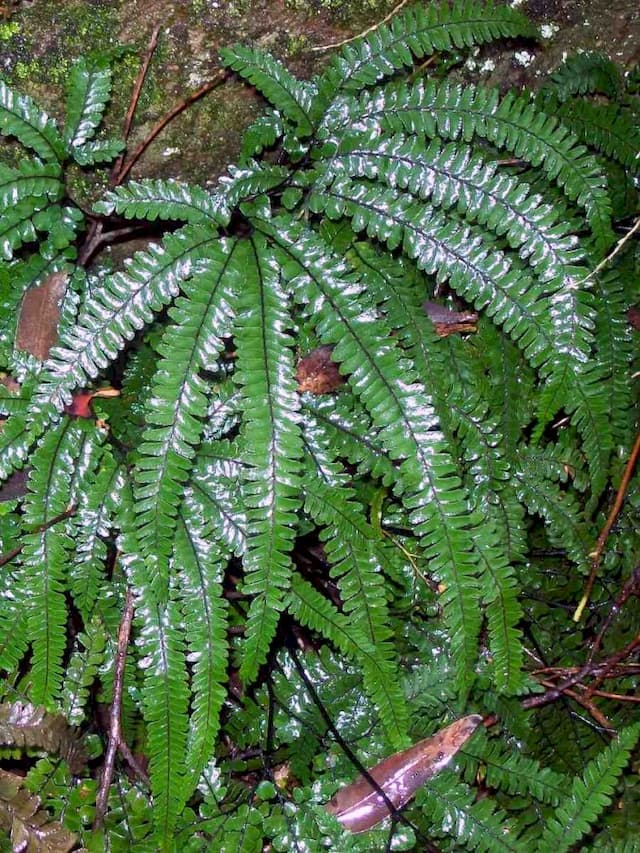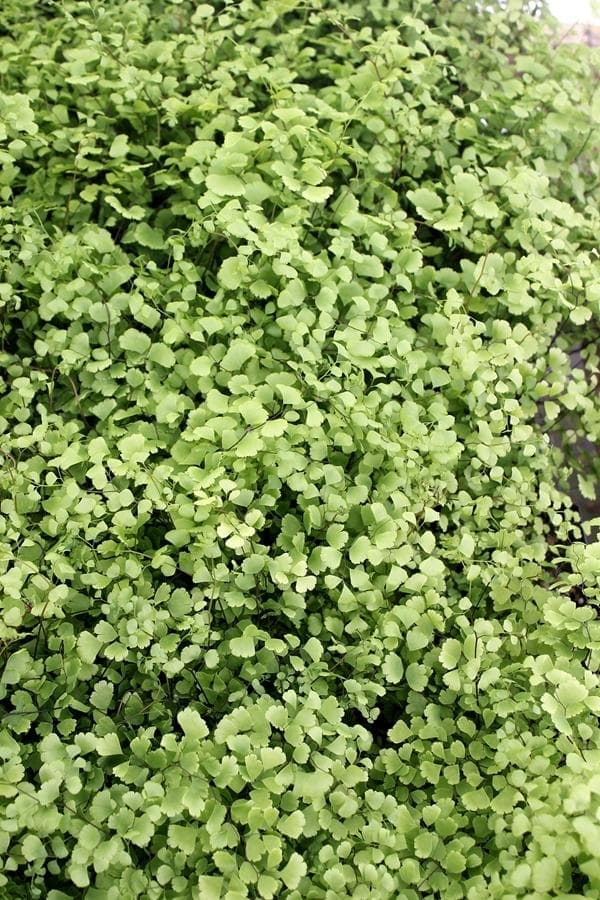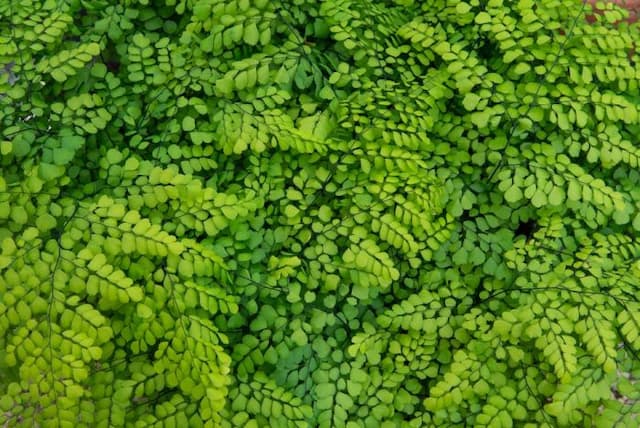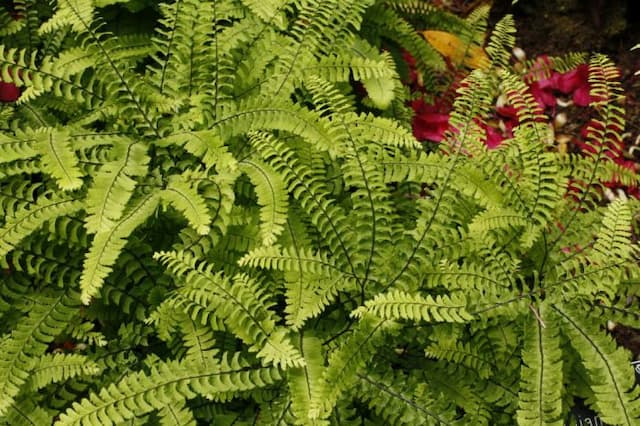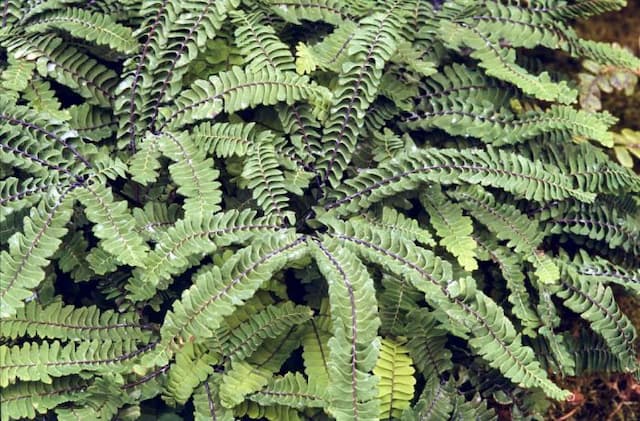Wavy Scaly Cloakfern Astrolepis sinuata

ABOUT
The plant, commonly known as the wavy cloak fern, has distinctive fronds that can add an interesting texture to any garden or landscape. The fronds are vibrant green and are characterized by a unique, wavy, or curled edge, which is where it gets its common name from. It has a thick and leathery texture which helps it conserve water and endure dry conditions. Each leaflet on the frond displays a dimpled and bumpy surface, and they are typically spread out along the frond's stem. This gives the plant a somewhat rugged, yet aesthetically appealing look. The backsides of the fronds have a coloration that varies from white to tan, which stands out against the greenery. The overall shape of the fronds can be described as roughly lanceolate, tapering to a point at the end and broader at the base where it connects to the central stem. The combination of the wavy margins and the textured leaflets creates a visually striking plant that can stand out in its native habitat or as a chosen ornamental specimen.
About this plant
 Names
NamesFamily
Pteridaceae.
Synonyms
Wavy Scaly Cloakfern, Wavyleaf Fern, Sinuate Scaly Cloakfern, Curly Lipfern, Wavy Cloakfern.
Common names
Cheilanthes sinuata, Notholaena sinuata, Pellaea sinuata.
 Toxicity
ToxicityTo humans
The most common common name for Astrolepis sinuata is Wavy Scaly Cloakfern. There is limited specific information available on the toxicity of Wavy Scaly Cloakfern to humans. As a general practice, it is wise to avoid ingesting any part of a plant unless it is known to be safe. If you suspect poisoning from any plant, seek medical attention immediately. However, there is no widespread documentation of Wavy Scaly Cloakfern being poisonous or causing adverse effects upon ingestion.
To pets
The Wavy Scaly Cloakfern is known by its common name as such and does not have a documented history of being toxic to pets. Nevertheless, it's always prudent to prevent pets from ingesting plants that are not confirmed to be safe. If your pet does consume Wavy Scaly Cloakfern and exhibits unusual symptoms, contact your veterinarian as a precautionary measure.
 Characteristics
CharacteristicsLife cycle
Perennials
Foliage type
Evergreen
Color of leaves
Green
Height
1 foot (30 cm)
Spread
2 feet (60 cm)
Plant type
Fern
Hardiness zones
8
Native area
North America
Benefits
 General Benefits
General Benefits- Landscaping: Wave Fern, which is Astrolepis sinuata, is often used in xeriscaping and natural landscaping due to its low water requirements and ability to thrive in rocky or sandy soils.
- Erosion Control: Its root system helps stabilize soil, making it useful for preventing erosion, especially in arid regions.
- Drought Resistance: Wave Fern is highly drought-resistant, making it ideal for gardens in areas that experience water scarcity.
- Habitat Provision: It can provide habitat and food for wildlife, including birds and insects, which are attracted to its structure and potential for shelter.
- Heat Tolerance: Astrolepis sinuata can withstand high temperatures, making it suitable for hot climates where many other plants might suffer.
- Low Maintenance: Once established, it requires minimal care, which is beneficial for gardeners looking for plants that do not require frequent attention.
- Aesthetic Appeal: With its unique frond structure and texture, it adds visual interest and variety to garden designs and rockeries.
- Cultural Significance: Native American tribes have used various species of ferns, including those similar to Wave Fern, for different cultural practices, though not necessarily this species directly.
- Soil Improvement: As Wave Fern decays, it contributes to the organic matter in the soil, helping improve soil quality over time.
 Medical Properties
Medical PropertiesThis plant is not used for medical purposes.
 Air-purifying Qualities
Air-purifying QualitiesThis plant is not specifically known for air purifying qualities.
 Other Uses
Other Uses- Wave Hill often uses bear's-foot fern in container plantings and for seasonal displays due to its distinctive and ornamental fronds.
- In the southwestern United States, bear's-foot fern is sometimes planted to control erosion on slopes and banks as its root system helps to stabilize the soil.
- It is used in rock gardens for its ability to grow in well-drained gravelly substrates, which simulates its natural rocky habitats.
- Bear's-foot fern can serve as a biological indicator for ecologists, as its presence often indicates a limestone substrate with unique soil chemistry.
- Some gardeners grow bear's-foot fern in hanging baskets where its unusual foliage can drape decoratively over the sides.
- Enthusiasts of fairy gardens use bear's-foot fern to create natural-looking woodland settings in miniature scales.
- In xeriscaping, which requires minimal irrigation, bear's-foot fern is favored for its drought tolerance once established.
- Researchers sometimes study bear's-foot fern for insights into fern evolution and adaption to arid environments.
- Bear's-foot fern is occasionally used as a natural barometer as its fronds curl tighter when the air is dry and unfold when humidity increases.
- Artisans may use the intricate frond patterns of bear's-foot fern as inspiration for design in textiles and other decorative arts.
Interesting Facts
 Feng Shui
Feng ShuiThe Wavy Cloak Fern is not used in Feng Shui practice.
 Zodiac Sign Compitability
Zodiac Sign CompitabilityThe Wavy Cloak Fern is not used in astrology practice.
 Plant Symbolism
Plant Symbolism- Resilience - Astrolepis sinuata, commonly known as the Wavy Cloak Fern, often grows in harsh and arid environments, symbolizing the ability to thrive in difficult conditions.
- Protection - The Wavy Cloak Fern has developed adaptations to protect itself from the sun's intensity and desiccation, representing a shield against adversity.
- Solitude - Given its solitary growth habit in rocky crevices, this fern can represent the concept of self-sufficiency and finding strength from within.
- Longevity - Ferns are ancient plants that have survived through the ages, and the Wavy Cloak Fern, by extension, symbolizes the endurance of life and persistence through time.
- Adaptability - The ability of the Wavy Cloak Fern to adapt to extreme conditions denotes flexibility and the willingness to adjust to changing environments.
 Water
WaterThe Deseret fern should be watered when the top inch of soil feels dry to the touch, typically once every week or two, depending on the humidity and temperature of the environment. Use room temperature water and gently pour it around the base of the plant, avoiding the fronds, until water begins to drain from the bottom of the pot. Allow excess water to drain away to prevent root rot. The amount of water needed at each watering can vary but aim to provide about 8-16 ounces each time depending on the pot size and environmental conditions.
 Light
LightThe Deseret fern thrives best in bright, indirect light. It should be placed in a spot where it receives filtered sunlight, such as near a window with a sheer curtain. Direct sunlight should be avoided as it can scorch the fronds, while too little light can cause decreased growth and poor frond development.
 Temperature
TemperatureThe Deseret fern prefers temperatures between 60°F and 80°F and should be protected from extreme temperatures. The plant can survive a minimum temperature of 50°F but growth may be stunted in cooler conditions. Ideal temperatures for optimal growth range around the 70°F mark.
 Pruning
PruningPruning the Deseret fern is necessary to remove dead or damaged fronds and to maintain the plant's shape. The best time to prune is in the spring or summer when the plant is actively growing. Use clean, sharp scissors to cut back any fronds that are brown or have dried out. Pruning can be done as needed, but it's generally not necessary to prune more than once or twice a year.
 Cleaning
CleaningAs needed
 Soil
SoilDesert fern thrives in well-draining soil with a mix of sand, peat, and loam; the ideal pH for the soil is slightly acidic to neutral, ranging from 6.0 to 7.0.
 Repotting
RepottingDesert fern should be repotted every 2-3 years or when it becomes root-bound, to promote healthy growth and prevent nutrient depletion.
 Humidity & Misting
Humidity & MistingDesert fern prefers low to moderate humidity levels, typical of its native arid habitats but can tolerate higher humidity without issue.
 Suitable locations
Suitable locationsIndoor
Place desert fern in bright, indirect light and ensure good air circulation.
Outdoor
Plant in partial shade with good drainage and protect from heavy frost.
Hardiness zone
7-11 USDA
 Life cycle
Life cycleThe life cycle of Astrolepis sinuata, commonly known as the Wavy Scaly Cloak Fern, begins with the dispersal of spores, which are produced in structures called sporangia located on the undersides of mature fronds. Once the spores land in a suitable moist environment, they germinate into a heart-shaped prothallus, the gametophyte stage, which is a small, green, photosynthetic structure. The prothallus produces both male and female gametes, and if water is present, sperm can swim to an egg to fertilize it, resulting in the growth of a new sporophyte. This sporophyte initially develops as a small fern that eventually grows into the adult plant. Adult Wavy Scaly Cloak Ferns develop characteristic pinnate fronds with a scaly appearance and will repeat the reproductive cycle by producing new spores, thus completing their life cycle. Over time, the fern may form colonies through vegetative reproduction, where parts of the plant give rise to new individuals, contributing to the spread of the species in its environment.
 Propogation
PropogationPropogation time
Spring-Early Summer
The most popular method of propagation for the Astrolepis sinuata, commonly known as the Wavy Cloak Fern, is through spore cultivation. The process involves collecting ripe spores from the underside of mature fronds when they turn a brownish color. These spores are then sown on the surface of a sterilized, fine-textured, moist potting mix ideally suited for ferns. The container of spores must be kept in a warm place with indirect light and a consistent humidity level. Covering the container with a clear plastic wrap can help maintain the necessary humidity. Germination can vary but often takes several weeks to months. Once the spores have germinated and the young ferns have grown large enough to handle, they can be carefully transplanted into individual pots.
